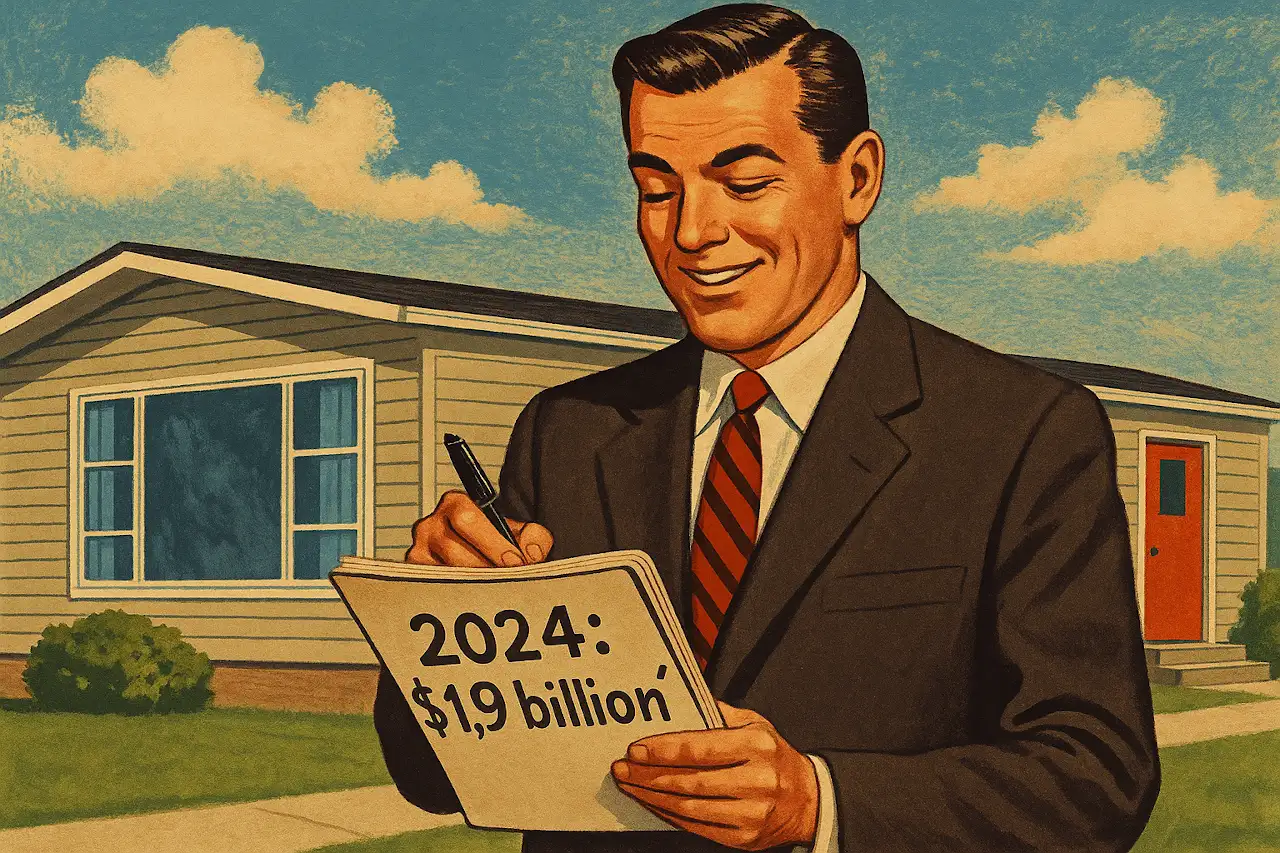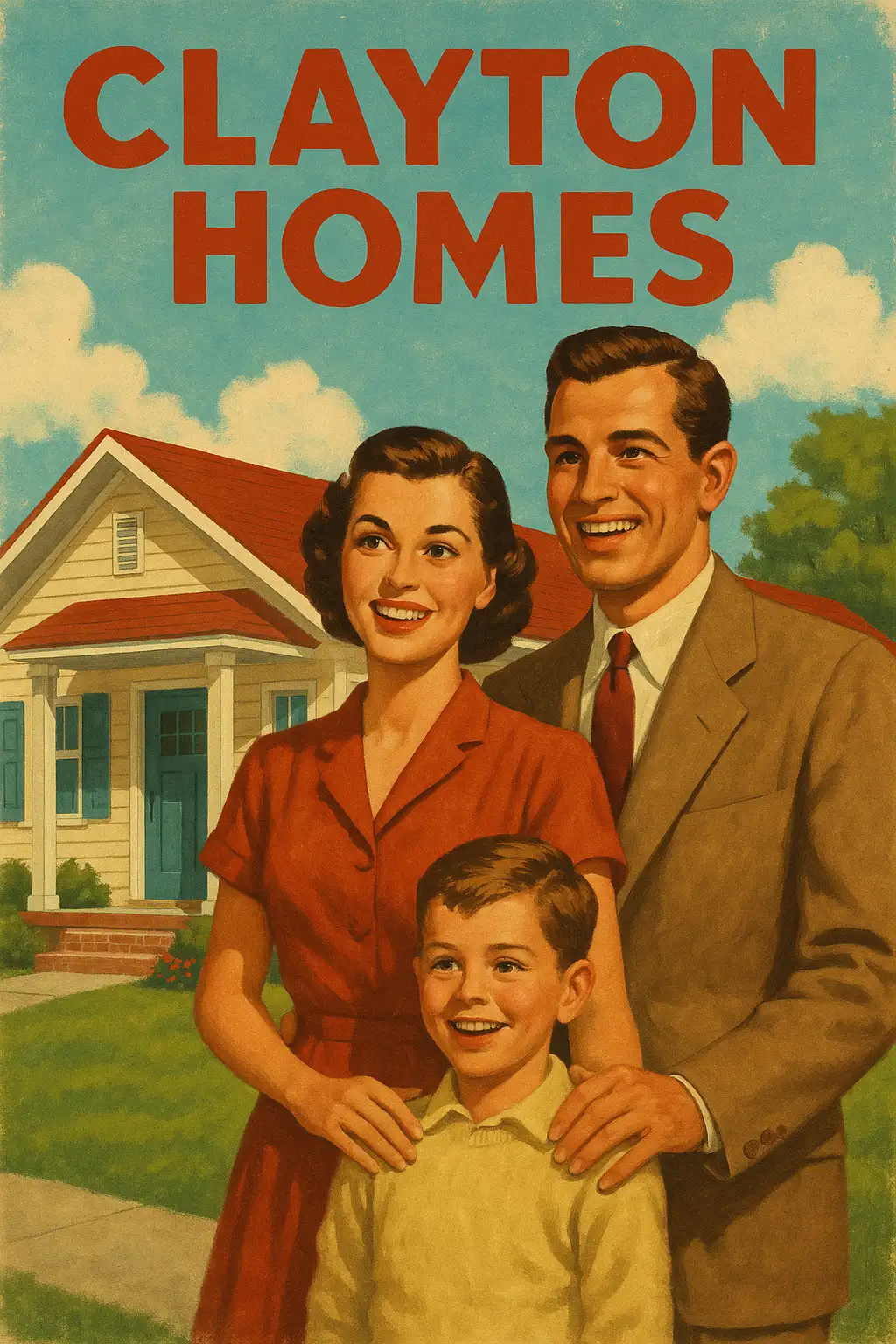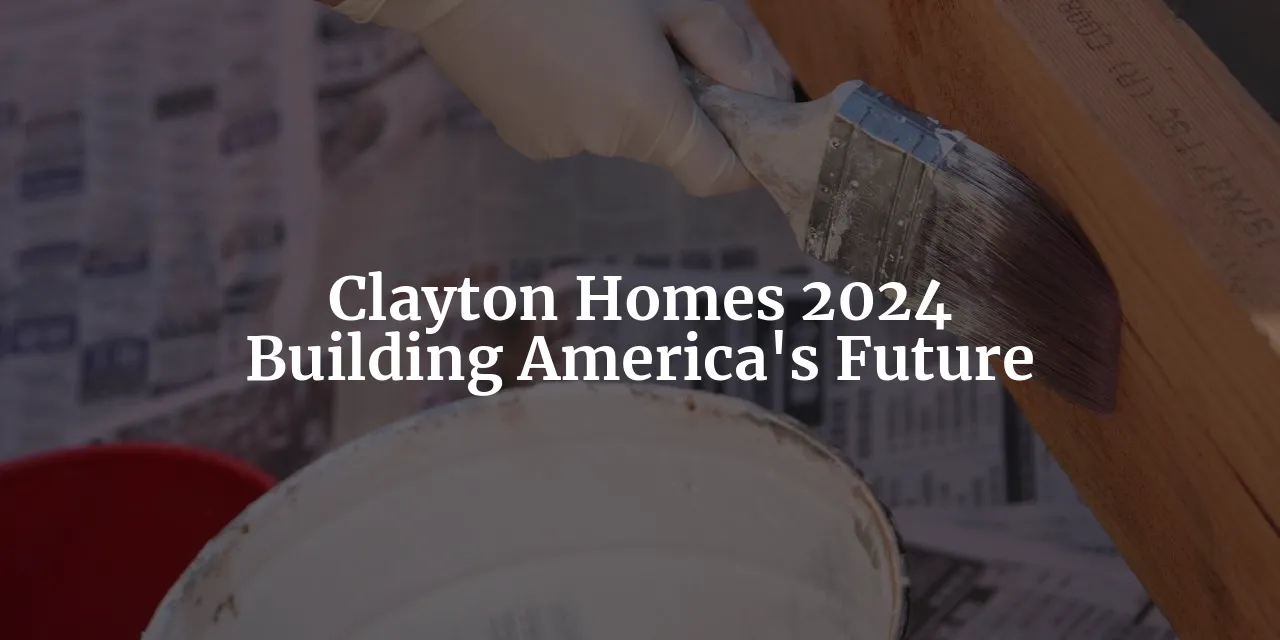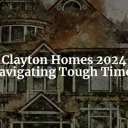Tags: Clayton Homes / Earnings
This fanpage is not officially affiliated with Berkshire Hathaway: Disclaimer
We review Berkshire Hathaway's Clayton Homes’ 2024 performance and future prospects through the lens of American innovation, from postwar factory-built housing to today’s modular revolution. This comprehensive review covers financials, investments, market dynamics, regulatory challenges, and social impact.

Introduction
Few companies capture the spirit of American innovation and resilience quite like Clayton Homes, Inc. As a proud subsidiary of Berkshire Hathaway, Clayton stands at the crossroads of tradition and transformation, forging the future of American housing just as factory-built homes did in the postwar boom. In the 1950s, when the nation’s veterans and young families craved affordable, quality living, it was the mobile home—refurbished, resold, and eventually manufactured by visionaries like Jim Clayton—that answered the call 2. Today, that same drive animates Clayton’s mission, now amplified by scale, technology, and a relentless pursuit of the American Dream.
This article presents a comprehensive review of Clayton Homes’ 2024 performance—and a forward-looking analysis tailored for Berkshire Hathaway shareholders. We will examine not only the financial results, but also the evolving market landscape, regulatory headwinds, and the company’s growing social and environmental footprint. The story of Clayton is one of legacy and new frontiers: from its humble Knoxville beginnings to its current status as a national leader in off-site and site-built housing, with over 20,600 employees, $12.4 billion in 2024 revenue, and more than 61,000 homes built this year 13.
The 2003 acquisition by Berkshire Hathaway marked a pivotal moment—one that echoes Warren Buffett’s “buy and hold” philosophy with other American icons. Clayton’s journey since then has been defined by strategic expansion, product innovation (from CrossMod™ ↗ to modular and tiny homes), and a steadfast commitment to affordability, quality, and sustainability 29.
As we chart Clayton’s 2024, we’ll blend financial analysis with market dynamics, regulatory realities, and the broader social impact of housing. This is a story that resonates with historic echoes—from the mobile home’s rise in the 1950s to today’s CrossMod™ and modular breakthroughs, Clayton’s evolution mirrors the shifting tides of American society and economy 29.
So, whether you’re a numbers-driven investor, a market watcher, or a believer in the enduring promise of the American home, join us for an engaging, analytical, and entertaining journey through Clayton Homes’ 2024—a year that underscores both the challenges and the opportunities of forging America’s housing future.
2024 in Review: Performance, Production, and Profits
2024 was a year of contrasts and complexity for Clayton Homes, reflecting both the resilience of its business model and the headwinds buffeting the broader housing sector. Revenues climbed 8.5% to $12.4 billion, a testament to robust demand and operational scale, even as pre-tax earnings declined 5.6% to $1.89 billion, squeezed by margin pressures and a shifting sales mix 3 ↗. This duality—growth amid challenge—defines the year’s narrative.
To appreciate Clayton’s trajectory, consider the following five-year performance snapshot:
| Year | Revenue ($B) | Pre-tax Earnings ($B) |
|---|---|---|
| 2019 | 7.3 | 1.10 |
| 2020 | 8.6 | 1.25 |
| 2021 | 10.5 | 1.70 |
| 2022 | 12.7 | 2.40 |
| 2023 | 11.4 | 2.00 |
| 2024 | 12.4 | 1.89 |
This table underscores a remarkable revenue rebound from 2023’s dip, but also highlights the margin compression that defined 2024—a year shaped by both opportunity and constraint.
On the production front, Clayton delivered approximately 51,000 off-site built homes—with over 95% meeting the Department of Energy’s Zero Energy Ready Home requirements, a milestone in sustainable construction. The company also completed about 10,000 site-built homes, reinforcing its dual-platform strategy 1. As of December 2024, the off-site backlog stood at $700 million, signaling continued demand and operational momentum 1.
Macroeconomic forces played a pivotal role. The rapid rise in U.S. mortgage interest rates during 2022 and 2023—reminiscent of the Volcker era’s rate hikes—dampened demand for new homes, even as the supply of pre-existing homes remained historically tight 1. In late 2024, rates edged down slightly, offering a glimmer of relief but not enough to fully reverse affordability pressures.
The year’s growth story was nuanced: new home unit sales surged 11.5%, but this was offset by lower average selling prices and a changing sales mix, reflecting industry-wide efforts to address the affordability crisis 3. Clayton’s ability to increase volume in a challenging market speaks to its operational agility and value proposition.
The financial services segment was a bright spot for top-line growth, with revenues up 15.5% thanks to higher interest income from increased average loan balances—reaching $27.2 billion net by year-end 3. However, profits were tempered by a rise in homeowner property insurance claim losses, higher loan loss provisions, and increased interest expense on borrowings from Berkshire finance affiliates 3.
Manufacturing earnings declined 9.4%, pressured by increased costs to meet stringent DOE Zero Energy Ready Home standards—partially offset by income tax credits 3. This underscores the growing importance of environmental compliance and ESG investment. Clayton incurred both capital and non-capital expenditures for stormwater protection, erosion control, and permitting in its site-built subdivisions, aligning with rising investor and regulatory expectations for sustainability 1.
From an operation standpoint, 2024 was a year of strategic adaptation: Clayton Homes balanced growth in unit sales and market share with the realities of margin pressure, regulatory complexity, and evolving consumer needs. The company’s ability to deliver volume, innovate in sustainability, and navigate financial headwinds positions it as a formidable force in America’s housing future.
Market Position: Clayton in the Prefab & Modular Landscape
Prefabricated and modular housing are a fastly growing market, in which Clayton Homes stands as the undisputed leader in the United States, shaping the future of American housing much as Levitt & Sons did in the postwar era with Levittown. Today, the market is defined by a new set of titans—Clayton Homes Inc., Champion Home Builders Inc., Cavco Industries Inc., Palm Harbor Homes Inc., Skyline Champion Corporation, and Fleetwood Homes Inc.—each vying for share in a sector projected to grow at a 5.8% CAGR from $36.1 billion in 2024 to $60.0 billion by 2033 9. Among these, Clayton’s scale, innovation, and integration make it the Berkshire Hathaway of prefab, consistently outpacing rivals in both production and influence.
Factory-built homes—whether modular, manufactured, CrossMod™, or tiny—offer advantages that echo Henry Ford’s assembly line revolution: reduced construction time, cost efficiency, customization, and sustainability. In 2024, Clayton completed approximately 51,000 off-site built homes, with over 95% meeting the Department of Energy’s Zero Energy Ready Home standards, a testament to its commitment to cutting-edge sustainability 1. This is not just a nod to consumer preference; it is a strategic imperative as buyers increasingly demand eco-friendly, energy-efficient, and flexible housing options 9.
Clayton’s CrossMod™ homes—which blend the affordability and speed of manufactured homes with the aesthetics and financing advantages of modular construction—represent a leap forward in design innovation, directly addressing the dual challenges of affordability and consumer skepticism. The company’s forays into tiny homes and advanced digital fabrication further position it at the vanguard of customization and rapid deployment, meeting the needs of urban millennials, downsizing boomers, and communities facing acute housing shortages.
Globally, the modular construction market is expected to expand at a 4.7% CAGR, from $103.9 billion in 2025 to $131.2 billion by 2030, driven by surging construction in China and India, cost-effectiveness, and sustainability imperatives 8. Clayton’s inclusion among the world’s major players—alongside Laing O'Rourke, Red Sea Housing, VINCI, Skanska, and Lendlease—underscores its international stature and strategic relevance.
Yet, the path is not without obstacles. The industry continues to wrestle with persistent negative perceptions regarding prefab quality and durability—a legacy of the 1970s and 1980s manufactured housing surge, when rapid expansion sometimes outpaced quality control. Regulatory hurdles—including complex zoning, building codes, and permitting—remain formidable, varying dramatically by state and municipality 9. Supply chain volatility and skilled labor shortages add further complexity, echoing the challenges faced during past housing booms and busts.
Clayton’s ability to navigate these headwinds—by leveraging its distribution network, proprietary financing, and relentless focus on innovation and sustainability—positions it to not only capture market share but to define the very standards by which the industry is measured. In many ways, Clayton is forging a new Levittown for the 21st century: scalable, sustainable, and ready to meet America’s evolving housing needs.
Economic and Political Headwinds
The journey to forge America’s housing future is shaped as much by economic and political forces as by innovation and consumer demand. In 2024, Clayton Homes—like its peers—faces a gauntlet of macroeconomic headwinds that threaten to reshape the cost structure and competitive dynamics of the prefab and modular housing industry.
Tariffs have emerged as a particularly acute risk. The imposition of 25% tariffs on Canadian and Mexican goods, alongside 20% duties on Chinese imports, threatens to increase the price of a new single-family home by $7,500 to $10,000 6. For an industry built on the promise of affordability, these cost shocks are reminiscent of the Smoot-Hawley Tariff era, when well-intentioned protectionism led to widespread economic disruption. The potential doubling of Canadian softwood lumber tariffs to above 50% in 2025 is especially concerning, given that a significant portion of U.S. homebuilders’ lumber is sourced from Canada. As Jessica Hansen of D.R. Horton notes, “If we've got a cost category that's inflating and we're in a gross margin compressing environment, we're going to renegotiate anything and everything that we can” 6.
Supply chain disruptions—first laid bare by the COVID-19 pandemic—continue to reverberate through the industry. While Clayton reported adequate access to key inputs like lumber, steel, and resin in 2023 and 2024, the specter of volatile pricing and availability remains 1. These disruptions are not new; they echo the cycles of boom and bust that have characterized American housing since the 19th century, from the timber shortages of the postwar building boom to the inflationary spikes of the 1970s.
Labor shortages present another formidable challenge, particularly in border states where proposed immigration policies could further constrain the workforce and drive up costs 6. The threat of mass deportations and stricter immigration enforcement may exacerbate existing shortages of skilled labor trained in prefabricated construction techniques, potentially slowing build times and eroding margins.
The interest rate environment has also exerted a significant influence. The sharp rise in mortgage rates during 2022 and 2023 dampened homebuyer demand, though this was partially offset by a historic low supply of pre-existing homes 1. As rates began to decline slightly in late 2024, some relief emerged, but the interplay between financing costs and housing affordability remains a delicate balancing act.
Layered atop these market forces are regulatory compliance costs. Clayton’s homebuilding business incurs both capital and non-capital expenditures to meet environmental regulations—from erosion control and permitting to stormwater protection for site-built subdivisions 1. This growing role of government oversight, dating back to the New Deal and the rise of the EPA, reflects society’s increasing demand for responsible development and environmental stewardship.
Yet, government is not merely a source of constraint; it is also a catalyst. Federal incentives—including stimulus packages, grants, and tax credits—have played a crucial role in supporting affordable housing and green building initiatives 9. These echoes of past federal housing programs, from the GI Bill to the Low-Income Housing Tax Credit, underscore the enduring partnership between public policy and private innovation in addressing America’s housing needs.
Clayton’s ability to navigate tariffs, supply chain volatility, labor shortages, interest rate fluctuations, and regulatory complexity will determine not only its own fortunes, but the trajectory of the entire prefab and modular housing industry. As history shows, those who adapt with agility and foresight will emerge as the architects of the next American housing renaissance.
Financing, Regulation, and Legal Scrutiny
As America’s largest builder of manufactured and modular homes, Clayton Homes occupies a unique—and often scrutinized—position at the intersection of housing finance, regulation, and consumer protection. In 2024, Clayton’s financial services division managed a loan portfolio of approximately $27.2 billion, an increase of 14% over the previous year, with the majority of these loans funded by Berkshire Hathaway affiliates 3. This proprietary approach to loan underwriting, leveraging both scale and the financial strength of its parent, allows Clayton to compete aggressively on price, service, and delivery capabilities 1. Yet, the very scale and reach that empower Clayton’s growth also expose the company to heightened regulatory and legal scrutiny.
The Consumer Financial Protection Bureau (CFPB), created in the wake of the 2008 financial crisis and the Dodd-Frank Act, has intensified its oversight of manufactured housing lenders. In 2024, the CFPB filed a high-profile lawsuit against Vanderbilt Mortgage & Finance, a Clayton subsidiary, alleging that the company “ignored clear and obvious red flags” regarding borrowers’ ability to repay, approving loans for families with significant debts in collection 4. CFPB Director Rohit Chopra accused Vanderbilt of “knowingly trapping people in risky loans in order to close the deal on selling a manufactured home.” These allegations echo earlier accusations of predatory lending and discrimination that have dogged the company since the mid-2010s, despite public denials and robust defenses from both Clayton Homes and Warren Buffett himself. As Buffett noted, “We have 300,000 loans on the books and in the last 3 years I've not received one letter of complaint from anybody” 2.
Clayton’s leadership asserts that its lending practices are fully compliant with all state and federal laws, including rigorous standards for verifying income and assessing a borrower’s ability to repay. The company points to the CFPB’s own review, which found less than 0.8% of loans problematic, as evidence of sound underwriting and responsible lending 4. Vanderbilt Mortgage has characterized the CFPB’s lawsuit as “politically motivated, regulatory overreach,” warning that excessive regulation risks depriving creditworthy borrowers of the opportunity for homeownership 4. This tension—between regulatory vigilance and the imperative to expand access to affordable housing—has become a defining feature of the post-crisis housing finance landscape.
The regulatory environment for Clayton’s financing business is complex, involving oversight from the CFPB, the U.S. Department of Housing and Urban Development (HUD), the Government National Mortgage Association (Ginnie Mae), and a patchwork of state agencies 1. The evolving “ability to repay” standards, a legacy of the Dodd-Frank reforms, require lenders to document and verify borrower incomes, living expenses, and overall creditworthiness—a process that can be especially challenging in the manufactured housing sector, where buyers are often lower-income and have less traditional credit profiles.
Compounding these challenges, financing and appraising manufactured homes remains more difficult than for traditional site-built homes. Many lenders remain wary, leading to higher interest rates, stricter terms, and fewer financing options for buyers—a structural barrier that continues to limit consumer access and market growth 9. The appraisal gap between manufactured and site-built homes can also hinder resale values and perpetuate negative perceptions about quality and durability.
Historically, the expansion of homeownership in America—from the FHA’s postwar mortgage insurance programs to the GI Bill—was driven by innovations in both housing finance and public policy. Today, Clayton’s experience underscores how the modern regulatory regime, while designed to protect consumers, can also create friction for those seeking to innovate and expand access to affordable housing. The company’s ongoing legal and regulatory challenges will remain a critical area of focus for shareholders and policymakers alike, as the industry seeks to balance consumer protection, financial stability, and the promise of the American Dream.

Social Impact, Sustainability, and Community Initiatives
At the heart of Clayton Homes’ mission is a commitment to social impact, sustainability, and community uplift—a legacy that stretches from the postwar housing boom to the 21st-century push for energy efficiency and affordable homeownership. In 2024, over 95% of Clayton’s 51,000 off-site built homes met the U.S. Department of Energy’s Zero Energy Ready Home program requirements, setting a new industry benchmark for sustainable construction 1. This achievement not only reduces utility costs for homeowners but also positions Clayton as a leader in the national drive toward greener, more resilient housing.
Clayton’s impact extends far beyond its production lines. Through its “A Future Begins at Home” initiative, launched in 2019, the company has partnered with organizations like Family Promise to address homelessness and housing insecurity. To date, Clayton has donated over 18 homes to Family Promise’s national network and provided more than $20,000 in direct grants to support families in crisis 5. The initiative has served over 30,000 families, helping them find stable housing and avoid the trauma of shelter displacement. As Amy M. Morgan, Executive Director of Family Promise of Greater Roanoke, observed, “The partnership…will allow us to serve more families. The goal is to prevent families from coming into shelter by providing short-term case management and services to help them overcome the largest obstacle to finding suitable housing” 5.
Public-private partnerships have been central to Clayton’s approach. The company has collaborated with nonprofits such as Next Step to build modular duplexes for affordable housing and worked with Oak Ridge National Laboratory and Skidmore, Owings & Merrill to pioneer 3D-printed homes—evoking the spirit of postwar innovation that once fueled America’s suburban expansion 2. These efforts reflect a broader vision: leveraging advanced manufacturing, digital design, and sustainable materials to redefine what is possible in American housing.
Clayton’s expansion into traditional site-built housing—with nearly 300 subdivisions and 66,000 homesites controlled as of 2024—demonstrates its commitment to serving a diverse spectrum of buyers and communities 1. The company’s dedication to quality, innovation, and workforce development has earned it a place among Forbes’ Best Employers and a consistent ranking in the Top 10 of Builder Magazine’s homebuilders 2. Its designer series homes have garnered media acclaim, further enhancing the brand’s reputation for affordability, style, and sustainability.
Beneath these achievements lies a profound social mission: addressing America’s affordable housing shortage, supporting homeless families, and promoting homeownership as a pillar of the American Dream. Clayton’s work is a modern echo of the postwar era, when housing policy and private enterprise combined to lift millions into the middle class ↗. Today, as urbanization, economic inequality, and environmental challenges reshape the landscape, Clayton’s integrated approach—combining philanthropy, innovation, and sustainable building practices—offers a blueprint for how the industry can drive both business success and social progress.
In a time of acute housing need, Clayton’s initiatives remind us that homeownership remains a cornerstone of social mobility and community stability. By investing in people, places, and the planet, Clayton Homes is not just building houses—it is forging the future of American housing.
Looking Ahead: Growth, Innovation, and Strategic Vision
As Clayton Homes enters the latter half of the 2020s, its strategic vision is defined by bold investments, relentless innovation, and a commitment to shaping the future of American housing. The company’s recent $42 million investment in Conway, Arkansas is emblematic of this forward-looking mindset. This expansion will modernize a 220,000-square-foot facility to produce an estimated 3,000 homes annually, creating more than 250 new jobs over the next three years. The new plant’s state-of-the-art, climate-controlled environment not only insulates production from weather-related delays but also signals a broader trend of reshoring American manufacturing—a move that strengthens domestic supply chains and revitalizes local economies 7. As Keith Holdbrooks, CEO of Clayton Home Building Group, noted, “With the need for affordable housing greater than ever, Conway is an ideal location to expand our modern manufactured home building operations... Together, Clayton and Conway can be a force for good.”
But Conway is just the beginning. Clayton’s roadmap for the future is paved with innovation across product lines and processes. The company is accelerating its CrossMod™ expansion, delivering homes that blend the affordability and efficiency of manufactured housing with the aesthetics and permanence of site-built homes—an answer to evolving consumer preferences and regulatory requirements 1. The continued rollout of tiny homes and the integration of smart home technologies reflect a keen understanding of shifting demographics, urbanization, and the growing demand for customization and energy efficiency 9.
On the operational front, advanced digital fabrication—including Building Information Modeling (BIM), robotics, and automation—will be central to Clayton’s ability to scale production, enhance quality, and drive sustainability. These technologies reduce construction time, minimize waste, and enable greater design flexibility, positioning Clayton to meet the needs of both first-time buyers and downsizing retirees 9.
The market context for these initiatives is compelling ↗. The U.S. prefabricated housing market is projected to reach $60 billion by 2033, growing at a robust CAGR of 5.8% 9. Globally, the modular construction sector is forecasted to expand from $103.9 billion in 2025 to $131.2 billion by 2030, propelled by urbanization, cost pressures, and sustainability imperatives 8. Clayton’s scale, brand reputation, and vertically integrated operations make it uniquely positioned to capture a disproportionate share of this growth.
However, success in this dynamic environment will require more than capacity and capital. Clayton’s strategic priorities include:
- Adapting to regulatory complexity across jurisdictions, ensuring compliance while advocating for policies that recognize the quality and safety of modern prefab homes.
- Strengthening supply chains to buffer against material price volatility and disruptions—a lesson reinforced by the pandemic era.
- Investing in workforce development, from recruiting in Conway to upskilling employees in digital construction techniques, ensuring Clayton remains an employer of choice in a tight labor market.
- Enhancing consumer perceptions of prefab quality, leveraging marketing, design innovation, and third-party certifications to challenge outdated stigmas and showcase the superior performance of today’s modular and manufactured homes.
Additionally, Clayton’s proven track record of M&A and partnerships—from acquiring regional builders like Chafin Communities and Goodall Homes to collaborating with research institutions and design leaders—offers a template for future growth 2. In an industry where scale, local expertise, and technological know-how are decisive, such alliances will be instrumental in expanding geographic reach, diversifying product offerings, and accelerating the adoption of next-generation building methods.
In many ways, Clayton stands at a historic crossroads. Just as the Levitt brothers revolutionized postwar suburbia, Henry Ford democratized the automobile, and Franklin Roosevelt’s New Deal reshaped the American landscape, Clayton Homes is poised to redefine what it means to own a home in the 21st century. For Berkshire Hathaway shareholders, this is more than a story of profits—it is a testament to the enduring power of innovation, resilience, and vision in forging the next chapter of the American Dream.

Conclusion
Clayton Homes’ 2024 journey stands as a compelling chapter in the ongoing evolution of American housing—a story that intertwines historic legacy, strategic innovation, and resilient adaptation ↗. As a Berkshire Hathaway subsidiary, Clayton has not only upheld the tradition of delivering affordable, quality homes but has also boldly embraced the future through technological advancement, sustainability leadership, and market expansion. The company’s performance this year—marked by robust revenue growth amid margin pressures, a surge in unit sales, and a pioneering commitment to Zero Energy Ready Homes—reflects both the opportunities and complexities inherent in today’s housing landscape 13. At the end, Clayton Homes earned around $1.9 billion pre-tax, which is a very good figure.
Positioned as the undisputed leader in the U.S. prefabricated and modular housing market, Clayton Homes channels the spirit of postwar innovators like Jim Clayton and Levitt & Sons, leveraging scale, integration, and product diversity to meet the evolving demands of American homebuyers. Its CrossMod™ line and ventures into tiny homes and smart technologies underscore a keen responsiveness to shifting demographics and affordability challenges, while its expansive manufacturing footprint signals a renewed emphasis on reshoring and supply chain resilience 179.
Yet, Clayton’s path forward is not without headwinds. The company must deftly navigate a complex regulatory environment, including intensified scrutiny of its financing operations, evolving zoning and building codes, and the persistent stigma surrounding manufactured housing. External pressures—from tariffs and labor shortages to fluctuating interest rates—further complicate this landscape, demanding agility and foresight reminiscent of the bold industrialists who shaped America’s economic rise 46. Clayton’s ability to balance regulatory compliance with innovation will be critical in sustaining its competitive edge and expanding homeownership access.
Beyond financial metrics, Clayton’s social impact and sustainability initiatives reveal a deeper commitment to the American Dream. By delivering energy-efficient homes, supporting homeless families through philanthropy, and partnering with research institutions to pioneer new building technologies, Clayton embodies a modern vision of corporate responsibility that echoes the transformative housing policies of the New Deal and postwar era 15. This holistic approach not only strengthens communities but also enhances shareholder value by aligning business success with societal progress.
Looking ahead, Clayton’s strategic investments—such as the Conway expansion—and its embrace of digital fabrication, modular innovation, and workforce development position it to capitalize on a prefabricated housing market projected to grow significantly over the next decade 79. The company’s integration of manufacturing excellence, financing strength, and design innovation offers a blueprint for scaling affordable, sustainable housing in a manner that few competitors can match.
For Berkshire Hathaway shareholders, Clayton Homes represents more than a business unit; it is a living testament to Warren Buffett’s buy-and-hold philosophy, a durable enterprise rooted in American values and poised to shape the nation’s housing future. As Clayton continues to forge new frontiers—balancing tradition with transformation—it stands ready to meet the housing challenges of the 21st century with the same pioneering spirit that once revolutionized suburbia and built the middle class.
Clayton Homes’ 2024 performance and strategic vision affirm its role as a formidable force in the American housing sector, blending financial resilience, innovative leadership, and social purpose. Its trajectory offers shareholders a compelling blend of growth potential and enduring value, anchored by a mission that remains as vital today as it was in the postwar boom: to make the American Dream of homeownership accessible, sustainable, and inclusive for generations to come.
References
-
2024 Annual Report - Clayton Homes - www.berkshirehathaway.com ↩↩↩↩↩↩↩↩↩↩↩↩↩↩↩↩↩
-
2024 Annual Report - Clayton Homes (Results of Operations) - www.berkshirehathaway.com ↩↩↩↩↩↩↩↩
-
Consumer watchdog says Berkshire Hathaway unit ignored red flags in manufactured home loans - apnews.com ↩↩↩↩
-
Clayton gifts $20K to Family Promise to support homeless families - www.wfxrtv.com ↩↩↩
-
Trump's Tariffs Could Increase New Home Prices Up To $10K, Builders Warn: Here's Why - dailyvoice.com ↩↩↩↩
-
Clayton Homes to Invest $42M in Conway Expansion - armoneyandpolitics.com ↩↩↩
-
Modular Construction Market Forecast Report 2025-2030: Growing Construction Activities in China and India are Forecast to Drive Market Expansion - finance.yahoo.com ↩↩
-
US Prefabricated Housing Market Size, Share, Forecast 2033 - www.custommarketinsights.com ↩↩↩↩↩↩↩↩↩↩↩↩












